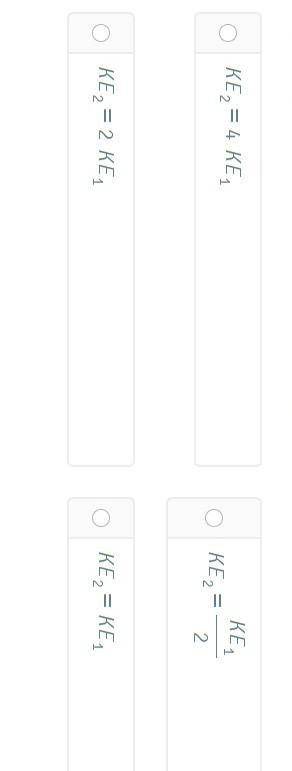
Physics, 25.04.2021 14:00 muhammed95
An object of mass m moving at a speed of v1 possesses kinetic energy that is equal to KE1. When the object's speed is doubled, the kinetic energy becomes KE2. How can you relate KE2, to KE1?
Answer and I will give you brainiliest


Answers: 3
Another question on Physics

Physics, 21.06.2019 18:10
Scientists use laser range-finding to measure the distance to the moon with great accuracy. a brief laser pulse is fired at the moon, then the time interval is measured until the "echo" is seen by a telescope. a laser beam spreads out as it travels because it diffracts through a circular exit as it leaves the laser. in order for the reflected light to be bright enough to detect, the laser spot on the moon must be no more than 1.0 km in diameter. staying within this diameter is accomplished by using a special large-diameter laser. part a if λ = 540nm , what is the minimum diameter of the circular opening from which the laser beam emerges? the earth-moon distance is 384,000 km. express your answer to two significant figures and include the appropriate units.
Answers: 1

Physics, 22.06.2019 12:30
Brades exam guidelines exam instructions billing & payments & support question 6 of 20 : select the best answer for the question use this illustration to answer the question below. forms & resources al programs 9 ww linics 6. in the circuit shown in the figure above, suppose that the value of r, is 100k, and the value of r2 is 470 kq. at which of the following locations in the circuit would you measure the highest voltage with your meter? rvices 999999 a. between points b and c b. between points a and b c. between points b and e d. between points a and c eredu mark for review (will be highlighted on the review page) mend < < previous question next question
Answers: 1

Physics, 22.06.2019 15:30
To understand the behavior of the electric field at the surface of a conductor, and its relationship to surface charge on the conductor. a conductor is placed in an external electrostatic field. the external field is uniform before the conductor is placed within it. the conductor is completely isolated from any source of current or charge. part a: which of the following describes the electric field inside this conductor? it is in the same direction as the original external field.it is in the opposite direction from that of the original external field.it has a direction determined entirely by the charge on its surface.it is always zero. part b: the charge density inside the conductor is: 0non-zero; but uniformnon-zero; non-uniforminfinite part c: assume that at some point just outside the surface of the conductor, the electric field has magnitude e and is directed toward the surface of the conductor. what is the charge density η on the surface of the conductor at that point? express your answer in terms of e and ϵ0
Answers: 1

Physics, 22.06.2019 16:20
What is the mass of the water that is being heated? it requires 2,500 joules to raise a certain amount of water (c = 4.186 jig c) from 20.0°c to 60.0°c. o 159 o 40 g o 63 g o 80 g
Answers: 2
You know the right answer?
An object of mass m moving at a speed of v1 possesses kinetic energy that is equal to KE1. When the...
Questions




World Languages, 24.04.2020 21:24



Mathematics, 24.04.2020 21:24

English, 24.04.2020 21:24

Mathematics, 24.04.2020 21:24

History, 24.04.2020 21:24










Spanish, 24.04.2020 21:24



